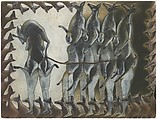Deers (venados)
Francisco Toledo Mexican
Not on view
At seventeen, Toledo began to train at the Taller Libre de Grabado in Mexico City. Three years later he moved to Paris, where he worked in the shop of the renowned British printmaker Stanley William Hayter. By the time he returned to Mexico in 1965, Toledo was recognized in Europe as a singular artist and celebrated for his "development of the mythic" and "his sacred sense of life." Settling in Oaxaca, he produced paintings and stone, wood, and wax sculptures, as well as graphics, the latter of which particularly intrigued him because of the extraordinary range of effects available through printing and etching.
Toledo's art is based on a fantastic realism that reflects a deep appreciation for, and astute observation of, nature, in particular, animals often not associated with beauty, such as insects, toads, and bats. Anthropomorphized creatures and metamorphosed objects are a persistent aspect of his work. Entitled Venados (Deer), this engraving in somber earth tones features four insect-eyed, bare-breasted female figures carrying a full-sized deer in an upright position on their shoulders. Held together by a rope, they are led by a fifth female figure with a male deer upon her head. Framing the composition are the heads and shoulders of profile deer.
Since Toledo worked in Hayter's atelier, it is not surprising that intaglio was among his preferred media. The exacting line of the engraver's burin allowed for the kind of elegant line and sharp detail evident in this print—from the long, curving lines of the women's torsos to the staccato strokes of the deer's fur. Toledo created subtle tonal passages in muted earth tones to complement his graceful lines using the technique of aquatint. The contrast between the dark, smoky tones of the composition and its passages of light enhance the mystical quality of this enigmatic image.
This image cannot be enlarged, viewed at full screen, or downloaded.


